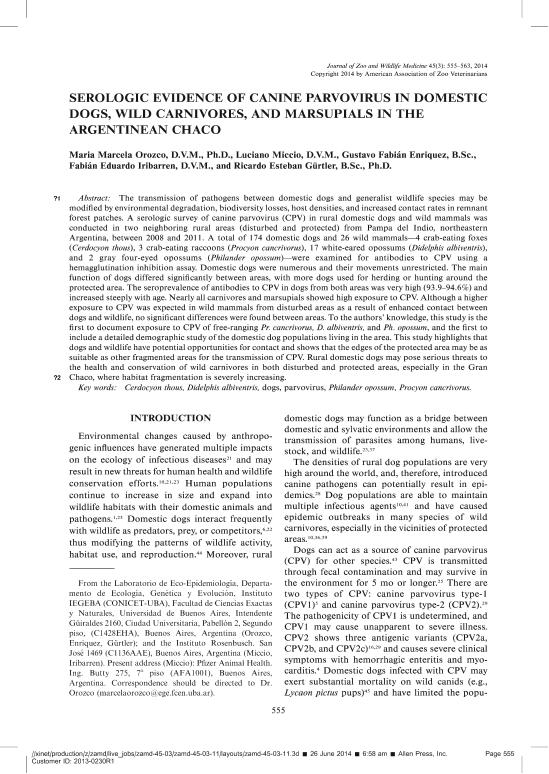Artículo
Serologic evidence of canine parvovirus in domestic dogs, wild carnivores, and marsupials in the argentinean Chaco
Orozco, Maria Marcela ; Miccio, Luciano; Enriquez, Gustavo Fabián
; Miccio, Luciano; Enriquez, Gustavo Fabián ; Iribarren, Fabián Eduardo; Gurtler, Ricardo Esteban
; Iribarren, Fabián Eduardo; Gurtler, Ricardo Esteban
 ; Miccio, Luciano; Enriquez, Gustavo Fabián
; Miccio, Luciano; Enriquez, Gustavo Fabián ; Iribarren, Fabián Eduardo; Gurtler, Ricardo Esteban
; Iribarren, Fabián Eduardo; Gurtler, Ricardo Esteban
Fecha de publicación:
09/2013
Editorial:
American Association of Zoo Veterinarians
Revista:
Journal of Zoo and Wildlife Medicine
ISSN:
1042-7260
e-ISSN:
1937-2825
Idioma:
Inglés
Tipo de recurso:
Artículo publicado
Clasificación temática:
Resumen
The transmission of pathogens between domestic dogs and generalist wildlife species may be modified by environmental degradation, biodiversity losses, host densities, and increased contact rates in remnant forest patches. A serologic survey of canine parvovirus (CPV) in rural domestic dogs and wild mammals was conducted in two neighboring rural areas (disturbed and protected) from Pampa del Indio, northeastern Argentina, between 2008 and 2011. A total of 174 domestic dogs and 26 wild mammals—4 crab-eating foxes (Cerdocyon thous), 3 crab-eating raccoons (Procyon cancrivorus), 17 white-eared opossums (Didelphis albiventris), and 2 gray four-eyed opossums (Philander opossum)—were examined for antibodies to CPV using a hemagglutination inhibition assay. Domestic dogs were numerous and their movements unrestricted. The main function of dogs differed significantly between areas, with more dogs used for herding or hunting around the protected area. The seroprevalence of antibodies to CPV in dogs from both areas was very high (93.9–94.6%) and increased steeply with age. Nearly all carnivores and marsupials showed high exposure to CPV. Although a higher exposure to CPV was expected in wild mammals from disturbed areas as a result of enhanced contact between dogs and wildlife, no significant differences were found between areas. To the authors' knowledge, this study is the first to document exposure to CPV of free-ranging Pr. cancrivorus, D. albiventris, and Ph. opossum, and include a detailed demographic study of the domestic dog populations living in the area. This study highlights that dogs and wildlife have potential opportunities for contact and shows that the edges of the protected area may be as suitable as other fragmented areas for the transmission of CPV. Rural domestic dogs may pose serious threats to the health and conservation of wild carnivores in both disturbed and protected areas, especially in the Gran Chaco, where habitat fragmentation is severely increasing.
Palabras clave:
Serologic
,
Parvovirus
,
Dogs
,
Chaco
Archivos asociados
Licencia
Identificadores
Colecciones
Articulos(IEGEBA)
Articulos de INSTITUTO DE ECOLOGIA, GENETICA Y EVOLUCION DE BS. AS
Articulos de INSTITUTO DE ECOLOGIA, GENETICA Y EVOLUCION DE BS. AS
Articulos(OCA CIUDAD UNIVERSITARIA)
Articulos de OFICINA DE COORDINACION ADMINISTRATIVA CIUDAD UNIVERSITARIA
Articulos de OFICINA DE COORDINACION ADMINISTRATIVA CIUDAD UNIVERSITARIA
Citación
Orozco, Maria Marcela; Miccio, Luciano; Enriquez, Gustavo Fabián; Iribarren, Fabián Eduardo; Gurtler, Ricardo Esteban; Serologic evidence of canine parvovirus in domestic dogs, wild carnivores, and marsupials in the argentinean Chaco; American Association of Zoo Veterinarians; Journal of Zoo and Wildlife Medicine; 45; 3; 9-2013; 555-563
Compartir
Altmétricas



